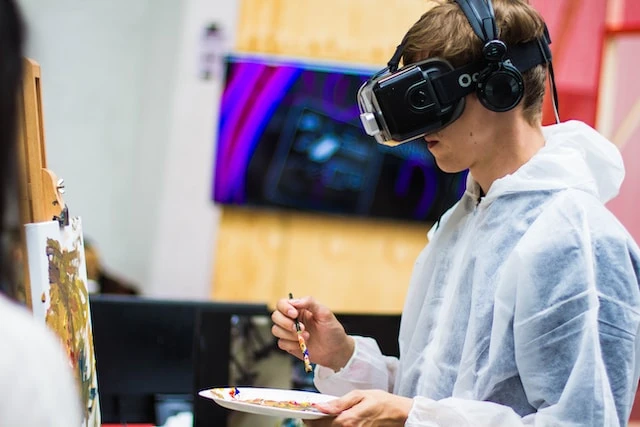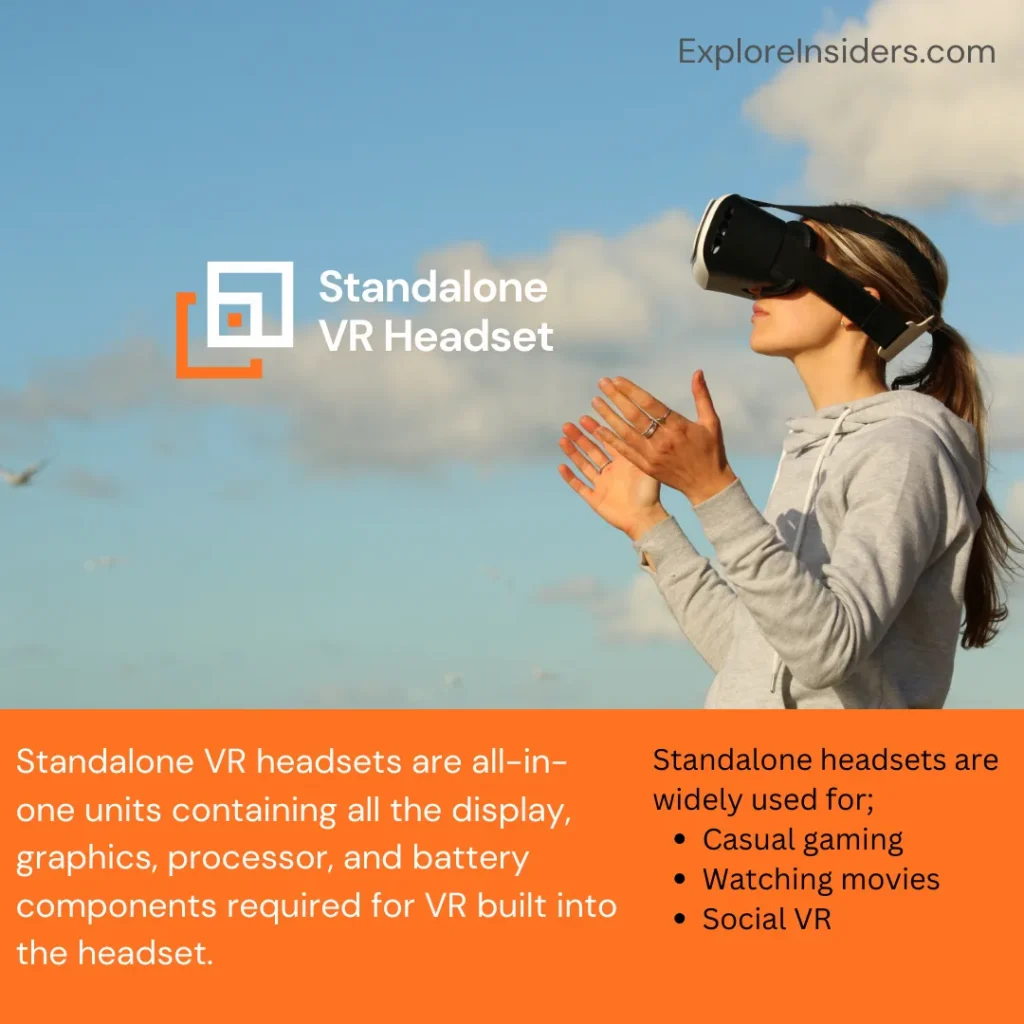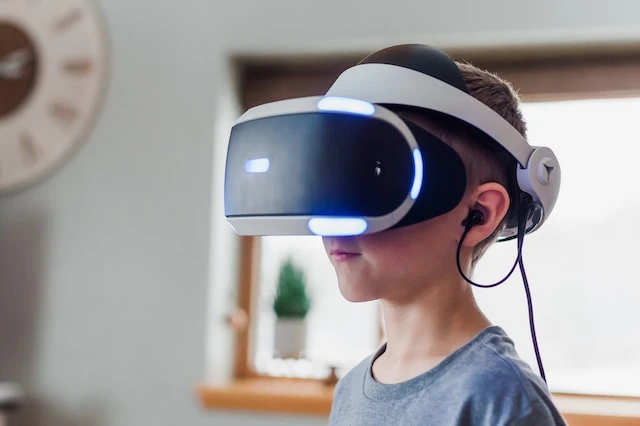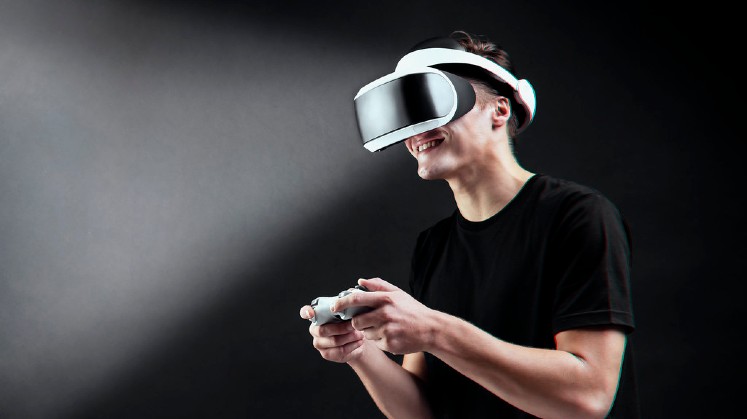Digitalization is coming at a serious pace, and we must prepare ourselves. It is bringing tools and technologies that are equally useful for businesses and households. Every sector has almost changed its basic infrastructure with technological advancements. We need to learn these incoming technological things and how to use them. One such tool that is spreading fast is virtual reality (VR). From entertainment parks to industrial and educational uses, this technology is going places. This article is a guide to the various types of VR headsets that are used for different purposes. Are you keen to know more about this virtual reality thing? Keep reading this article!
Top 3 Different Types of VR Headsets to Choose From
To discover the various experiences of virtual reality, three different types of VR headsets are available out there. Some need connectivity to the PC, while others can work in a standalone scenario. Every type comes with its unique properties and advantages. Users have to pick the one that better caters to their needs. Following are some of the top three types of virtual reality headsets you need to know. Let us walk through them quickly!
1. Tethered Virtual Reality Headsets:

The tethered headsets describe VR headsets that need to be physically connected to a PC, gaming console, or other external device via cables in order to function.
Tethered VR headsets are presently considerably more vivid than other types of headsets because of the great quality of experience they can convey. These superior VR headsets require a specific measure of arrangement space, just like a cable connection with a gaming PC. A tethered VR headset should be connected to a computer through a cable, such as HDMI or USB cable.
The idea of designing a headset that will require the least computing power is in its infancy. However, doing so will shrink the image and graphic quality of the VR headset. The tethered device is best for people who already own a computer system. Connecting it with a powerful gaming PC can give you an immersive experience.
Applications:
The tethered VR headset is used on many occasions. With its high-end virtual experiences, it is the choice of many. Following are some areas where this device is used widely.
- Professional sectors
- Gaming areas like theme parks
- Education sector
- Tourism departments
- Art and design departments
These sectors and departments are making smart technological moves by integrating smart VR devices. They have greatly automated their operations and are enjoying enhanced productivity levels.
Best Tethered VR Headsets Available Online
Popular tethered headsets like the Oculus Rift S, HTC Vive Cosmos, and PlayStation VR contain head-tracking features, display, and lenses in the headset itself. But the external machines powering them do the heavy lifting when processing graphics and imagery. The cables provide the vital link to transmit all this visual data at high speeds into the headset.
- Oculus Rift S – Advanced PC-powered headset with excellent 6DOF tracking.
- HTC Vive Cosmos – Solid PC VR headset with dynamic external tracking.
- PlayStation VR – Console VR headset compatible with PS4 and PS5.
Tethered headsets offer cutting-edge performance and graphics powered by gaming PCs and consoles. However, the cable connection limits mobility during use.
2. Standalone VR Headsets:

Standalone VR headsets are all-in-one units containing all the display, graphics, processor, and battery components required for VR built into the headset. Unlike the tethered headset, a standalone (all-in-one) virtual reality headset does not require physical tethers or connections to the PC, consoles, or mobiles.
This class of headsets requires the least dependency on computing power. They are independent headsets that work on a plug-in-and-play basis. The user only needs to charge the batteries and create an account to access various VR platforms. Apart from these, nothing else is required. Since these headsets have built-in sensors, batteries, and processors, they don’t need a connection to a PC.
The graphics quality of the standalone VR headsets is not as powerful as tethered VR headsets. However, tech giants like Google, Facebook, and HTC are improving this category. The device is good for those who don’t have access to a powerful gaming PC. It’s the best option for people who lack time to set up a complex gaming system.
Applications:
A standalone VR headset is used widely in different industries. However, we are enlisting a few names in the coming lines.
- Casual gaming
- Watching movies
- Social VR
Best Standalone VR Headsets Available Online
Headsets like the Meta Quest 2, HTC Vive Focus 3, and Oculus Go have powerful onboard hardware that can handle VR graphics and environmental processing without external dependencies. This makes them completely portable. However, their self-contained mobile hardware limits their capabilities compared to PC/console-powered tethered headsets.
- Meta Quest 2 – Advanced all-in-one virtual reality headset.
- HTC Vive Focus 3 – An enterprise-ready standalone VR headset.
- Oculus Go – An Easy-to-use VR headset with state-of-the-art 3D graphics.
Standalone headsets provide untethered use cases like room-scale VR without any cable constraints. However, onboard mobile hardware limits graphics and processing capabilities compared to tethered headsets.
3. Smartphone VR Headsets:
How would the virtual reality experience be when a smartphone provides it? It sounds fascinating! The idea is a reality now with the smartphone VR headsets in the town. These devices make use of the smartphone to provide virtual reality experiences. The Mobile headsets are designed specifically for smartphones. They consist of head mounts with lenses into which users slide their smartphones to transform into VR goggles.
The device works better on recently released mobile phones, showing more power to support it. The graphics quality depends on the power of the phone you are using the device with. The more recent the model, the higher the visual graphics. People with powerful smartphones can enjoy high-end VR experiences in their homes. Of all the headsets, this one comes at an affordable price.
Applications:
The smartphone virtual reality device is mainly used for the following purposes.
- Casual Gaming
- Watching movies
- Social VR experience
Since the VR apps use the smartphone’s camera and accelerometers, the quality depends on the phone’s specifications. Users hold these devices up to their faces to experience a seamless virtual reality show.
Best Smartphone VR Headsets Available Online
Popular picks like the Samsung Gear VR and Meta Quest 2 are created by tech giants to seamlessly sync with their own smartphones. Mobile headsets provide an easy entry point into VR via smartphones. However, the VR experiences are ultimately limited by the smartphone display and hardware capabilities.
- Samsung Gear VR – Compatible with Samsung phones.
- Bnext VR Headset – Best fit for smartphones with a 4” to 6.3” screen size.
- VR SHINECON VR Headset –Affordable mobile headset for Android/iOS phones.
Mobile headsets offer an inexpensive way to try basic VR using a smartphone. However, capabilities are limited by the smartphone’s hardware. Tracking is 3DOF only, and graphics lag behind PC/standalone VR.
Choosing the Right Type of VR Headsets

Virtual Reality (VR) technology has evolved dramatically over the past decade, bringing many options for enthusiasts and newcomers alike. But with several types of virtual reality devices available, how do you choose the perfect one? Here’s a guide to help you make the right decision:
Purpose & Application
- Gaming: If you’re an avid gamer looking for the most immersive experience, tethered VR headsets connected to a powerful PC or gaming console might be your best bet. They offer the highest resolution, fastest refresh rates, and superior motion tracking.
- Education & Training: For training simulations or educational applications where portability and ease of setup are crucial, standalone VR headsets can be an excellent choice. They offer a decent balance of performance without the need for external hardware.
- Entertainment & Casual Use: For users who want a taste of VR without a hefty investment, smartphone VR headsets are ideal. They’re perfect for watching 360-degree videos or trying out basic VR apps.
Budget Constraints
- High-End Experience: If budget isn’t a constraint and you seek the best visual fidelity, go for tethered VR headsets. While they can be pricey, the experience they deliver is unmatched.
- Mid-Range: Standalone VR devices offer a middle ground in price and performance. They provide a good VR experience without breaking the bank.
- Budget-Friendly: Smartphone virtual reality headsets are the most affordable. They rely on your phone’s screen and sensors, making them a cost-effective entry point into VR.
Space & Mobility
- Room-Scale VR: Tethered VR headsets often support room-scale VR, allowing you to walk around and interact within a virtual space. However, this requires a considerable amount of physical space free from obstacles.
- Limited Space & Portability: Standalone VR headsets are perfect for those with limited space or those who want a VR device they can carry around. With no wires or external sensors, they offer a hassle-free experience.
- Sedentary Experience: Smartphone virtual reality headsets are generally designed for seated experiences, making them suitable for users with minimal space.
Ease of Setup
- Complex Setup: Tethered virtual reality headsets require a more intricate setup involving external sensors, cameras, and a compatible PC or console.
- Plug & Play: Standalone and smartphone VR devices typically offer a more straightforward setup. For standalone devices, it’s about charging, powering on, and jumping into VR. For smartphone VR, it’s just about sliding your phone into the headset.
Expandability & Future-Proofing
- Regular Upgrades: Tethered VR headsets, especially those connected to PCs, can benefit from hardware upgrades, such as graphics cards, ensuring they remain up-to-date with the latest VR titles and software.
- Fixed Hardware: Standalone VR headsets have fixed internal hardware, so while they offer convenience, they might become outdated quicker than tethered alternatives.
The right virtual reality device depends on your specific needs, budget, and intended use. Research each option, read user reviews, and, if possible, test them out before purchasing. By doing so, you can ensure that you invest in a VR experience that you’ll enjoy for years to come.
These VR headsets are used widely in theme parks. Kids and adults can play games in VR parks using these devices. Are you interested in playing such high-end virtual games? Grab your VR Park Dubai tickets today and pay a visit!
Conclusion
The virtual reality headset landscape offers extensive choices catering to all platforms. Tethered solutions provide cutting-edge performance powered by gaming PCs and consoles. Standalone and mobile headsets emphasize portability and ease of use.
Carefully matching headset capabilities and compatibility with your chosen device is key. Consider your budget, target experience level, and performance needs; for immersive high-fidelity VR, PC and tethered headsets are ideal. For unfettered mobility, grab a standalone or mobile headset.
With this comprehensive guide covering the major VR headset categories and popular models, finding your perfect virtual reality match is now easier. Get ready to step into amazing VR worlds!
Editor Choice:
- Meta Quest 2 — Advanced all-in-one virtual reality headset
- Oculus Rift S — Advanced PC-powered headset.
- Samsung Gear VR — Best VR headset for Samsung phones.
Frequently Asked Questions:
How many types of VR headsets are there?
There are primarily three types of VR headsets: standalone devices, tethered devices, and smartphone headsets. However, the other types are hybrid, augmented reality, and mixed reality headsets.
What is the best VR headset for PC?
Top VR headsets for PC include the Valve Index, HTC Vive Pro 2, and Oculus Rift S.
Which VR headset has the best graphics?
Tethered headsets like the Vive Pro 2, Valve Index, and HP Reverb G2 have the most powerful graphics powered by gaming PCs.
What is the most famous VR headset?
The Meta Quest 2 (aka Oculus Quest 2) is currently the most famous and advanced virtual reality headset.
Is PlayStation VR a good VR headset?
Yes, PlayStation VR is a solid mid-range VR headset compatible with PS4 and PS5 consoles.
Which is the cheapest type of VR?
Basic mobile headsets like the Google Cardboard and smartphone VR goggles are the most affordable entry-level VR headsets.
Do I need a PC for Oculus Quest 2?
No, the Oculus Quest 2 (aka Meta Quest 2) is a standalone headset that does not require a PC. But it can connect to a PC wirelessly for enhanced graphics.
Which VR headset has the widest field of view?
The Valve Index and Pimax headsets boast some of the widest fields of view up to 130-170 degrees.
What is the highest-resolution VR headset?
Currently, the HTC Vive Pro 2 offers the highest display resolution at 5K or 2448×2448 pixels per eye.
Recommended Posts:
An Ultimate Guide To A VR Headset
Demystifying Virtual Reality on iPhone: A Comprehensive Guide
Various Types of Virtual Reality and Applications
Setting Up Your VR Headset: Step-by-Step Instructions
Top 20 Tips for a Seamless VR Experience
The Future of Virtual Reality: Exploring the Possibilities
Top 16 Safety Considerations in Virtual Reality
Exploring the Potential of Virtual Reality (VR) in Various Industries
For more follow https://www.exploreinsiders.com


